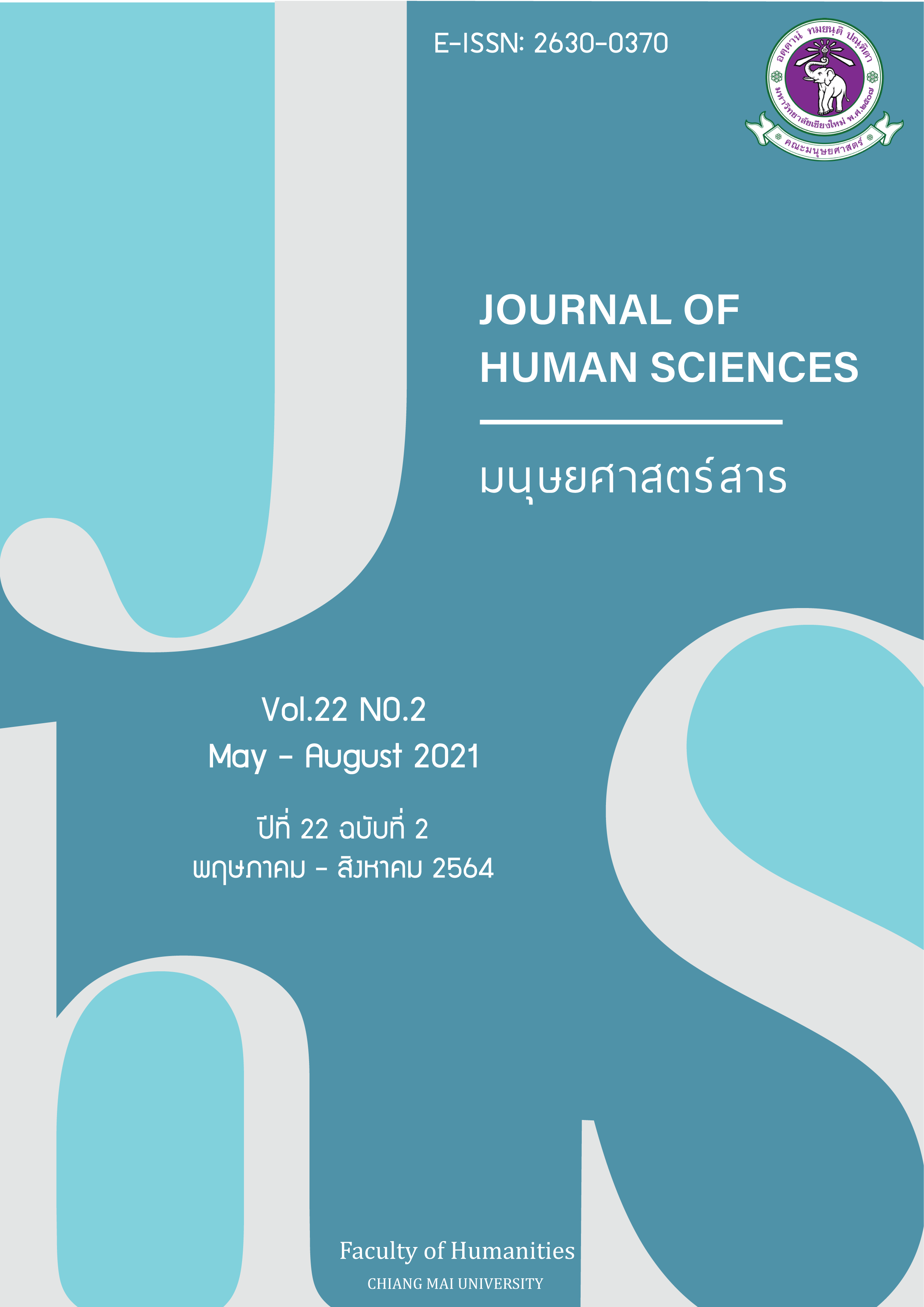อุดมการณ์แฝงในเพลงสันทนาการไทย: การวิเคราะห์วาทกรรมเชิงวิพากษ์
Main Article Content
บทคัดย่อ
บทความวิจัยนี้มีวัตถุประสงค์เพื่อนำเสนอผลการวิจัยเกี่ยวกับอุดมการณ์แฝงในเพลงสันทนาการไทยตามกรอบทฤษฎีการวิเคราะห์วาทกรรมเชิงวิพากษ์ประกอบกับกรอบแนวคิดการวิเคราะห์ เช่น กลวิธีทางวรรณศิลป์ กระบวนการการเลือกใช้คำและวัจนปฏิบัติศาสตร์เพื่อวิเคราะห์ตัวบทและบริบทของวาทกรรมเพลงข้อมูลที่ใช้ในการศึกษาวิเคราะห์คือเพลงสันทนาการจากเว็บไซต์อีคิว กรุ๊ป บล็อกสปอตจำนวน 136 เพลง ผลการวิเคราะห์พบว่าอุดมการณ์แฝงอยู่ในเพลงสันทนาการไทยคืออุดมการณ์ความเกลียดกลัวคนรักเพศเดียวกัน อุดมการณ์ปิตาธิปไตยและอุดมการณ์ลำดับชั้นซึ่งได้แก่ลำดับชั้นตามอายุและอาชีพ ผ่านการใช้กลวิธีทางศัพท์ กลวิธีทางวัจนปฏิบัติศาสตร์และกลวิธีทางวาทศิลป์รวม 14 กลวิธีอันประกอบไปด้วย การใช้คำเรียกขาน การอ้างถึง การใช้คำกริยา การเล่นคำ การขยายความ การใช้มโนภาพ การใช้มูลบท การใช้วัจนกรรม การใช้คำแสดงทัศนภาวะ การปฏิเสธ การสัมผัสอักษร การสัมผัสสระ การซ้ำคำตามโครงสร้างและการซ้ำคำ
Article Details
เอกสารอ้างอิง
Angkapanichkit, J. (2014). Kan wikhro kho khwam [Discourse Analysis]. Bangkok: Thammasat University Press.
Arp, T. R., Johnson, G. & Perrine, L. (2005). Perrine's literature: Structure, sound, and sense. Boston: Thomson Wadsworth.
Attali, J. (1985). Noise: The political economy of music. Minneapolis: University of Minnesota Press.
Brown, S., & Volgsten, U. (2006). Music and manipulation: On the social uses and social control of music. NY: Berghahn Books.
Bucholtz, M. (2003). Theories of discourse as theories of gender: Discourse analysis in language and gender studies. In J. Holmes & M. Meyerhoff (eds.), The Handbook of Language and Gender (pp. 43-68). Malden: Blackwell.
Eamsa-Ard, L. (2006). Thai popular music: The representation of national identities and ideologies within a culture in transition. (Doctoral dissertation, Edith Cowan University). Retrieved from http://ro.ecu.edu.au/theses/62
Fairclough, N. (2009). A dialectical-relational approach to critical discourse analysis in social research. In R. Wodak & M. Meyer (eds.), Methods of Critical Discourse Analysis
(pp. 162-187). London: Sage.
Fairclough, N. (2010). Critical discourse analysis: The critical study of language (2nd ed.).
NY: Routledge.
Herek, G. M. (2000). The psychology of sexual prejudice. Current directions in psychological science, 9(1). 19-22.
Herek, G. M. (2004). Beyond “homophobia”: Thinking about sexual prejudice and stigma in the twenty-first century. Sexuality Research & Social Policy, 1(2). 6-24.
Iwanaga, K. (2008). Women and politics in Thailand: Continuity and change. Copenhagen: NIAS Press.
Jackson, P. A., & Sullivan, G. (1999). Lady boys, tom boys, rent boys: Male and female homosexualities in contemporary Thailand. Binghamton: The Haworth Press.
Ledgerwood, A., & Chaiken, S. (2007). Priming us and them: Automatic assimilation and contrast in group attitudes. Journal of Personality and Social Psychology, 93(6). 940-956.
Leone, M. (2012). My schoolmate: Protest music in present-day Iran. Critical Discourse Studies, 9(4). 347-362.
Machin, D., & Richardson, J. E. (2012). Discourses of unity and purpose in the sounds of fascist music: A multimodal approach. Critical Discourse Studies, 9(4). 329-345.
Martinez-Flor, A. (2008). Analysing request modification devices in films: Implications for pragmatic learning in instructed foreign language contexts. In E. Alcón & M. P. Safont (eds.), Intercultural Language Use and Language Learning (pp. 245-279). Amsterdam: Springer.
Palmer, F. R. (2001). Mood and modality. Cambridge: Cambridge University Press.
Piangbunta, S. (2013). Language and ideologies in sexual assault news headlines: A critical discourse analysis. Journal of Human Sciences, 14(2). 141-165.
Pornpitakpan, C. (2000). Trade in Thailand: A three-way cultural comparison. Business Horizons, 43(2). 61-61.
Rabibhadana, A. (1975). Clientship and Class Structure in the Early Bangkok Period. In G. W. Skinner, & A. T. Kirsch (eds.), Change and Persistence in Thai Society: Essays in Honor of Lauriston Sharp. London: Cornell University Press.
Rattanapakdee, O. (2009). Characteristics of traditional Thai folk song in modern recreational songs. Kasetsart Journal, Social Sciences, 30(1). 10-25.
Sassatelli, R. (2011). Interview with Laura Mulvey: Gender, gaze and technology in film culture. Theory, Culture & Society, 28(5). 123-143.
Searle, J. R. (1979). Expression and Meaning: Studies in the Theory of Speech Acts. Cambridge: Cambridge University press.
Sidanius, J., & Pratto, F. (2001). Social dominance: An intergroup theory of social hierarchy and oppression. Cambridge: Cambridge University Press.
Simpson, P. (2003). Language, ideology and point of view. London: Routledge.
Soikudrua, T. (2018). Language and ideology of dignity in the discourse of school marching songs in Thailand. KKU International Journal of Humanities and Social Sciences, 8(3). 44-65.
Stoller, S., & Nielsen, C. (2005). Asymmetrical genders: Phenomenological reflections on sexual difference. Hypatia, 20(2). 7-26.
Sultana, A. (2011). Patriarchy and women’s subordination: A theoretical analysis. Arts Faculty Journal, 4(1). 1–18.
Suriyasarn, B. (2014). Gender identity and sexual orientation in Thailand. Bangkok: ILO regional Office for Asia and the Pacific.
Union of Catholic Asian News. (2017). Women left behind in patriarchal Thailand.
Retrieved from https://www.ucanews.com/news/women-left-behind-in-patriarchal-thailand/83854
United Nation Development Programme in Thailand. (2018). Legal gender recognition in Thailand: A legal and policy review. Retrieved from https://www.th.undp.org/content/thailand/en/home/library/democratic_governance/ legal-gender-recognition-in-thailand--a-legal-and-policy-review.html.
Van der Wouden, T. (2002). Negative contexts: Collocation, polarity and multiple negation. London: Routledge.
Van Dijk, T. A. (1977). Text and context explorations in the semantics and pragmatics of discourse. London: Longman.
Van Dijk, T. A. (1995). Discourse semantics and ideology. Discourse and Society, 6(2), 89-243.
Van Dijk, T. A. (1997). The study of discourse. In T. A. van Dijk (eds.), Discourse studies:
A multidisciplinary introduction. Discourse as structure and process (pp. 1-34). London: Sage.
Van Dijk, T. A. (2006). Discourse and manipulation. Discourse and Society, 17(3). 359-383.
Van Leeuwen, T. (2012). The critical analysis of musical discourse. Critical Discourse Studies, 9(4). 319-328.
Widdowson, H. G. (2000). On the limitations of linguistics applied. Applied Linguistics, 21(1).
-25.
Widdowson, H. G. (2004). Text, context, pretext: Critical issues in discourse analysis. Oxford, England: Blackwell.
Withawaphinyo, P. (2015). Language strategies used in the patriotic song of Thailand’s National Council for Peace and Order - NCPO. Journal of Liberal Arts, 15(2). 145-161.
Zirker, A., & Winter-Froemel, E. (2015). Wordplay and metalinguistic/ metadiscursive reflection: Authors, contexts, techniques, and meta-reflection. Berlin: De Gruyter.


